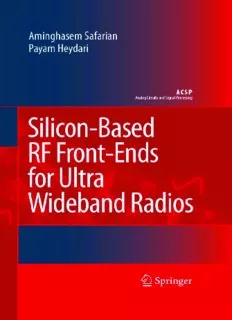Table Of ContentANALOG CIRCUITS AND SIGNAL PROCESSING
ConsultingEditor
MohammedIsmail
OhioStateUniversity
Forothertitlespublishedinthisseries,goto
http://www.springer.com
ANALOGCIRCUITSANDSIGNALPROCESSINGSERIES
ConsultingEditor:MohammedIsmail.OhioStateUniversity
TitlesinSeries:
SILICON-BASEDRFFRONT-ENDSFORULTRAWIDEBANDRADIOS
Safarian,A.,Heydari,P.
ISBN:978-1-4020-6721-1
CMOS SINGLE CHIP FAST FREQUENCY HOPPING SYNTHESIZERS FOR WIRELESS
MULTI-GIGAHERTZAPPLICATIONS
Bourdi,Taoufik,Kale,Izzet
ISBN:978-1-4020-5927-8
ULTRALOWPOWERCAPACITIVESENSORINTERFACES
Bracke,W.,Puers,R.(etal.)
ISBN:978-1-4020-6231-5
ANALOGCIRCUITDESIGNTECHNIQUESAT0.5V
Chatterjee,S.,Kinget,P.,Tsividis,Y.,Pun,K.P.
ISBN-10:0-387-69953-8
IQCALIBRATIONTECHNIQUESFORCMOSRADIOTRANCEIVERS
Chen,Sao-Jie,Hsieh,Yong-Hsiang
ISBN-10:1-4020-5082-8
BASEBANDANALOGCIRCUITSFORSOFTWAREDEFINEDRADIO
Giannini,Vito,Craninckx,Jan,Baschirotto,Andrea
ISBN:978-1-4020-6537-8
BROADBANDOPTO-ELECTRICALRECEIVERSINSTANDARDCMOS
Hermans,C.,Steyaert,M.
ISBN978-1-4020-6221-6
FULL-CHIPNANOMETERROUTINGTECHNIQUES
Ho,Tsung-Yi,Chang,Yao-Wen,Chen,Sao-Jie
ISBN:978-1-4020-6194-3
THEGM/IDDESIGNMETHODOLOGYFORCMOSANALOGLOWPOWERINTEGRATED
CIRCUITS
Jespers,PaulG.A.
ISBN-10:0-387-47100-6
ANALOG-BASEBANDARCHITECTURESANDCIRCUITS
FORMULTISTANDARDANDLOW-VOLTAGEWIRELESSTRANSCEIVERS
Mak,PuiIn,U,Seng-Pan,Martins,RuiPaulo
ISBN:978-1-4020-6432-6
DESIGNANDANALYSISOFINTEGRATEDLOW-POWERULTRAWIDEBANDRECEIVERS
Lu,IvanSiu-Chuang,Parameswaran,Sri
ISBN:978-1-4020-6482-1
CMOSMULTI-CHANNELSINGLE-CHIPRECEIVERSFORMULTI-GIGABITOPT...
Muller,P.,Leblebici,Y.
ISBN978-1-4020-5911-7
PRECISIONTEMPERATURESENSORSINCMOSTECHNOLOGY
Pertijs,MichielA.P.,Huijsing,JohanH.
ISBN-10:1-4020-5257-X
SWITCHED-CAPACITORTECHNIQUESFORHIGH-ACCURACYFILTERANDADC...
Quinn,P.J.,Roermund,A.H.M.v.
ISBN978-1-4020-6257-5
RFPOWERAMPLIFIERSFORMOBILECOMMUNICATIONS
Reynaert,Patrick,Steyaert,Michiel
ISBN:1-4020-5116-6
ADVANCEDDESIGNTECHNIQUESFORRFPOWERAMPLIFIERS
Rudiakova,A.N.,Krizhanovski,V.
ISBN1-4020-4638-3
CMOSCASCADESIGMA-DELTAMODULATORSFORSENSORSANDTELECOM
delRío,R.,Medeiro,F.,Pérez-Verdú,B.,delaRosa,J.M.,Rodríguez-Vázquez,A.
ISBN1-4020-4775-4
Silicon-Based RF Front-Ends
for Ultra Wideband Radios
Aminghasem Safarian
Broadcom Corporation,Irvine, CA, USA
Payam Heydari
UniversityofCalifornia, Irvine, CA, USA
AminghasemSafarian
BroadcomCorporation
Irvine,CA
USA
PayamHeydari
UniversityofCalifornia
Irvine,CA
USA
ISBN:978-1-4020-6721-1 e-ISBN:978-1-4020-6722-8
LibraryofCongressControlNumber:2007936933
(cid:2)c 2008SpringerScience+BusinessMediaB.V.
Nopartofthisworkmaybereproduced,storedinaretrievalsystem,ortransmitted
inanyformorbyanymeans,electronic,mechanical,photocopying,microfilming,recording
orotherwise,withoutwrittenpermissionfromthePublisher,withtheexception
ofanymaterialsuppliedspecificallyforthepurposeofbeingentered
andexecutedonacomputersystem,forexclusiveusebythepurchaserofthework.
Printedonacid-freepaper.
9 8 7 6 5 4 3 2 1
springer.com
To OurFamilies
Contents
1 Introduction .................................................... 1
1.1 OrganizationoftheBook ..................................... 1
2 UltraWidebandSystems......................................... 3
2.1 WirelessWorldofTechnologies ............................... 3
2.1.1 WPAN,WLAN,WWAN............................... 3
2.1.2 UWBTechnology..................................... 4
2.2 UWBApplications:HighSpeedShortRangeCommunication,
LongRangeLocalization ..................................... 6
2.3 UWBSignals ............................................... 7
2.4 AdvantagesofUltraWidebandoverNarrow-bandSystems......... 8
2.5 UWBTransceiverArchitecture ................................ 9
2.5.1 ImpulseRadio(IR)UWB .............................. 9
2.5.2 MB-OFDMUWB..................................... 10
2.6 Challenges ................................................. 12
2.7 LinkBudget ................................................ 12
References ...................................................... 13
3 UWBDistributedLowNoiseAmplifiers(DLNA).................... 15
3.1 WidebandLNAMatching..................................... 16
3.2 Background:DistributedCircuits .............................. 18
3.3 CMOSPerformance-optimizedDLNA.......................... 20
3.4 NoiseAnalysis.............................................. 25
3.4.1 BackgroundandCurrentStateofKnowledge.............. 26
3.4.2 NoiseContributionofMOSTransistors................... 27
3.4.3 NoiseContributionofSourceandLoadImpedances ........ 31
3.4.4 CalculationandOptimizationoftheOverallNF............ 32
3.5 LinearityAnalysis ........................................... 36
3.6 MeasurementResults ........................................ 37
3.7 Summary .................................................. 41
References ...................................................... 43
4 DistributedRFFront-End........................................ 45
4.1 UWBZero/LowIFDualConversionReceivers................... 45
vii
viii Contents
4.2 UWB-DRF ................................................. 46
4.2.1 CompositeLNTA/MixerCell ........................... 47
4.2.2 ProgrammableInputRFTLTermination.................. 48
4.2.3 ConversionGainCalculation............................ 48
4.3 ExperimentalResults ........................................ 51
4.4 Summary .................................................. 53
References ...................................................... 55
5 DistributedRFFront-EndforUWBDirectConversionReceiver...... 57
5.1 DistributedRFFront-EndforDirectConversionReceiver.......... 57
5.2 CurrentEqualizationtoRemoveIQGain/PhaseImbalances ........ 60
5.3 MeasurementResults ........................................ 64
5.4 Summary .................................................. 68
References ...................................................... 69
6 DistributedActivePowerCombinersandSplittersforMulti-Antenna
UWBBeamformingTransceivers ................................. 71
6.1 MA-UWBTransceiverArchitectureswithBeamforming........... 72
6.2 DistributedPowerCombinerandSplitter ........................ 75
6.2.1 Distributed Architecture with Broadband Variable
GainandDelay...................................... 75
6.2.2 DistributedActivePowerCombiners..................... 79
6.2.3 DistributedActivePowerSplitter........................ 80
6.2.4 PowerSplittersandCombinerswithShuntPeakingInductors 81
6.3 ExperimentalResults ........................................ 83
6.4 Summary .................................................. 88
References ...................................................... 88
7 Conclusions .................................................... 91
Index ............................................................. 93
Chapter1
Introduction
Ultra-wideband(UWB)technologyenableshighdata-rateshort-rangecommunica-
tion,inexcessofhundredmegabit-per-secondsanduptomulti-gigabit-per-seconds,
overawidespectrumoffrequencies,whilekeepingpowerconsumptionatlowlev-
els. This low power operation results in a less-interfering co-existence with other
existedcommunicationtechnologies(e.g.,UNIIbands).
Inadditionto carryinga hugeamountofdata overa distanceof upto 230feet
atverylowpower(lessthan0.5mW),theUWBsignalhastheabilitytopenetrate
through the doors and other obstacles that tend to reflect signals at more limited
bandwidthsandhigherpowerdensities.
The key attributes of UWB technology, therefore, include; high data rates,
ranging and communication applications, low equipment cost, and immunity to
the multipath fading. These features have motivated the researchers to investigate
performance-optimizedintegratedcircuit(IC)solutionsforUWBtechnology.
TobestutilizetheentireUWBspectrumspecifiedbytheFCCfrom3.1GHzupto
10.6GHz,theconstituenttransceivershouldoperateacrossthiswidespectralband.
Ontheotherhand,designingRFfront-endcircuits,particularlyinCMOStechnol-
ogy, for UWB transceivers entails stringent challenges associated with wideband
requirements.Infact, the RF front-endhasto exhibitwidebandRF characteristics
ofgain,noisefigure,andlinearity,aswellaslowpowerconsumption.Thescopeof
thisbookincludesdesignandanalysisofnovelwidebandRFfront-endsforUWB
transceiversin silicontechnologies.A greatdealofemphasiswill be madeonthe
explorationofnewperformance-optimizeddistributedintegratedcircuittopologies
forUWBwirelessradios.
1.1 Organizationofthe Book
The book is organized as follows: Chapter 2 provides an introduction to the his-
tory and applications of the UWB technology, and reviews the UWB transceiver
architecturesanddesignchallengesinUWBRFfront-enddesign.
Chapter 3 describes various techniques to design UWB low-noise amplifiers
in CMOS technology. Furthermore, we present the systematic design guideline
1
2 1Introduction
and analysis of a CMOS performance-optimized distributed low-noise amplifier
(DLNA).AsetofcomprehensiveanalysisoftheDLNA’sgainandnoisefigurewill
alsobedescribed.
Chapter 4 presents a novel distributed RF front-end which extends the idea of
distributed mixers to a distributed RF front-end, incorporating composite cell of
low-noisetransconductanceamplifier(LNTA)andmixer.ThisdistributedRFfront-
endismainlydesignedfordualconversionUWBreceivers.Designguidelinesand
implementationissuesofthedistributedRFfront-endwillbediscussed,extensively.
Chapter5extendstheconceptofdistributedarchitecturestodesignadistributed
direct-conversion RF front-end (DDC-RF) for the UWB receiver. Such RF front
front-endexhibitswidebandcharacteristic,whileaddressingthreeimportantissues
in any conventionaldistributed circuit, namely high power dissipation, large area,
and most importantly, the existing delay and loss from one tap-node of the con-
stituent transmission-line to the next which translates to in-phase and quadrature
(IQ)phaseandgainimbalances.ToovercomeIQmismatches,acurrentequalization
techniqueisillustrated.ThischapteralsoincludestheCMOSimplementationofthe
DDC-RFprototypeandmeasurementresults.
Chapter6employsthedistributedarchitectureinthedesignofnovelactivepower
combinersandsplitterswithcontrolleddelayandgain.Thesecircuitsarekeybuild-
ingblocksofmulti-antennaUWB(MA-UWB)transceivers.
Finally,Chapter7providesconcludingremarks.
Description:A comprehensive study of silicon-based distributed architectures in wideband circuits are presented in this book. Novel circuit architectures for ultra-wideband (UWB) wireless technologies are described. The book begins with an introduction of several transceiver architectures for UWB. The discussio

